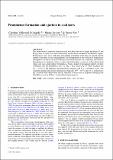Files in this item
Prominence formation and ejection in cool stars
Item metadata
| dc.contributor.author | Villarreal D'Angelo, Carolina Susana | |
| dc.contributor.author | Jardine, Moira Mary | |
| dc.contributor.author | See, Wyke Chun Victor | |
| dc.date.accessioned | 2018-02-06T17:30:06Z | |
| dc.date.available | 2018-02-06T17:30:06Z | |
| dc.date.issued | 2018-03-21 | |
| dc.identifier | 252193604 | |
| dc.identifier | 1a49ea58-7dcf-4207-91a6-032339cad3a8 | |
| dc.identifier | 000438222600006 | |
| dc.identifier | 85102962968 | |
| dc.identifier.citation | Villarreal D'Angelo , C S , Jardine , M M & See , W C V 2018 , ' Prominence formation and ejection in cool stars ' , Monthly Notices of the Royal Astronomical Society: Letters , vol. 475 , no. 1 , pp. 25-29 . https://doi.org/10.1093/mnrasl/slx206 | en |
| dc.identifier.issn | 1745-3925 | |
| dc.identifier.other | ORCID: /0000-0002-1466-5236/work/57821888 | |
| dc.identifier.uri | https://hdl.handle.net/10023/12682 | |
| dc.description | We acknowledge STFC (ST/M001296/1) and H2020 (682393). | en |
| dc.description.abstract | The observational signatures of prominences have been detected in single and binary G and K type stars for many years now, but recently this has been extended to the M dwarf regime. Prominences carry away both mass and angular momentum when they are ejected and the impact of this mass on any orbiting planets may be important for the evolution of exoplanetary atmospheres. By means of the classification used in the massive star community, that involves knowledge of two parameters (the co-rotation and Alfvén radii, rK and rA), we have determined which cool stars could support prominences. From a model of mechanical support, we have determined that the prominence mass mp/M*=(EM/EG)(r*/rK)2F where EMB2⋆r3⋆ and EG=GM2⋆/r⋆ are magnetic and gravitational energies and F is a geometric factor. Our calculated masses and ejection frequencies (typically 1016−1017g and 0.4 d, respectively) are consistent with observations and are sufficient to ensure that an exoplanet orbiting in the habitable zone of an M dwarf could suffer frequent impacts. | |
| dc.format.extent | 5 | |
| dc.format.extent | 243702 | |
| dc.language.iso | eng | |
| dc.relation.ispartof | Monthly Notices of the Royal Astronomical Society: Letters | en |
| dc.subject | Stars: coronae | en |
| dc.subject | Stars: magnetic field | en |
| dc.subject | Stars: low-mass | en |
| dc.subject | QB Astronomy | en |
| dc.subject | QC Physics | en |
| dc.subject | 3rd-NDAS | en |
| dc.subject.lcc | QB | en |
| dc.subject.lcc | QC | en |
| dc.title | Prominence formation and ejection in cool stars | en |
| dc.type | Journal article | en |
| dc.contributor.sponsor | Science & Technology Facilities Council | en |
| dc.contributor.sponsor | Science & Technology Facilities Council | en |
| dc.contributor.institution | University of St Andrews. School of Physics and Astronomy | en |
| dc.identifier.doi | 10.1093/mnrasl/slx206 | |
| dc.description.status | Peer reviewed | en |
| dc.identifier.grantnumber | ST/R00824/1 | en |
| dc.identifier.grantnumber | ST/M001296/1 | en |
This item appears in the following Collection(s)
Items in the St Andrews Research Repository are protected by copyright, with all rights reserved, unless otherwise indicated.

